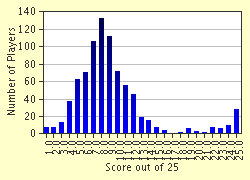Quiz Answer Key and Fun Facts
1. Which of the following is the so-called "Sword of Mercy" associated with Edward the Confessor and borne in the coronation ceremonies of English monarchs?
2. According, at least, to Geoffrey of Monmouth, what was the name of the sword borne by Julius Caesar?
3. According, at least, to William Shakespeare, what was the name of the sword borne by Marc Antony?
4. Which of the following is a sacred sword -- specifically one of the Sanshu no Shinki, or three great treasures given to Ninigi by his grandmother, the sun goddess Amaterasu -- in Japanese mythology?
5. What dragon-slayer bore the sword Balmung?
6. Which of the following is NOT a sword medieval writers ascribed ownership of to Mohammed?
7. Which of the following swords is said to have belonged originally to Hector of Ilium and (much later) to Count Roland of France?
8. With which wonderful sword did Oliver destroy no less than nine other magic swords, collectively representing the fruits of twenty-seven years' hard labor by the three greatest swordsmiths then living?
9. Which of the following is NOT a blade ownership of which is attributed at one point or another to Charlemagne?
10. What hero bore the swords Colada and Tizona?
11. What talking sword was taken from the Fomorians by the Irish god Ogma, according to the Book of Invasions?
12. What deadly magical sword was borne by the Irish demigod-hero Lugh?
13. In the Tain Bo Cualgne (the Cattle-Raid of Cooley), with what magical sword did Ferghus Mac Roich slice off the tops from three hills with a single stroke?
14. What sword was given to the Pendragon by the so-called Lady of the Lake?
15. According to Robert de Boron, which war leader came to power after drawing a sword out of an anvil?
16. What sword, associated with sixth-century Welsh King Rhydderch Hael, is numbered among the thirteen "Hallows of the Island of Britain"?
17. What sword was reforged by Sigurd from the shards of a blade broken by his father, and used by him to slay a dragon?
18. What magical sword did Kormak Ogmundsson the Skald borrow before fighting Bersi, to match Bersi's magic sword Whitting?
19. What accursed magic sword did Hervor seek from her dead father Angantyr?
20. At Ragnarok, what combatant will wield the dread sword Laevateinn, the "Staff of Destruction"?
21. What sword of reputedly divine origin was borne by Sir Artegal in Spenser's Faerie Queene?
22. With what terrible sword would Elric of Melnibone consign blood and souls to Arioch, Duke of Hell?
23. With what sword did Peter Pevensy slay a wolf called Fenris?
24. What name did the gigantic Northern barbarian Fafhrd give to any great broadsword he was able to keep long enough to develop a feeling of ownership for?
25. What wizard bore the sword known as Glamdring?
Source: Author
xaosdog
This quiz was reviewed by FunTrivia editor
bullymom before going online.
Any errors found in FunTrivia content are routinely corrected through our feedback system.

